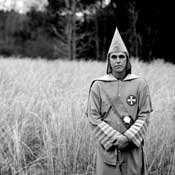Wednesday, May 4, 2011
It was dark and a cell-phone dead zone. James Edward Bates and a friend trudged through a few hundred yards of swampy woods in Vidor, Texas, to reach their car. Not far behind were three Klansmen, one quite agitated, who'd broken off from a group of about 80 in white robes, some wielding torches, or brandishing Bibles, at a Klan cross-lighting ceremony in 1998. For more than 12 years, Bates, 41, spent weekends driving into the night, sleeping upright in his Honda Accord, to document the truth of contemporary KKK activities in the American South.
Other intimidating and even life-threatening incidents caused Bates, a white Gulfport resident, to question his dedication. He asked himself, "Am I in this for the long haul, or am I only in this when it's safe?"
The long haul it was.
Bates' photojournalism has appeared in numerous publications ranging from Biloxi's Sun Herald, to The New York Times to Rolling Stone. As a Baptist, he describes the longitudinal KKK project as his "calling." He's also photographed missionary trips to South America and Romania.
Though the exhibit already hung on the walls of foreign countries, his Klan photos have met reticence in the United States. Thus, it debuts at the University of Southern Mississippi, Bates' alma mater ('95 graduate). In November 2010, Bates was also inducted into USM's Mass Communication and Journalism Hall of Fame for this project and work in the aftermath of Hurricane Katrina.
For five months in 1998, Bates broke bread and built trust with a Klan member, an "average guy," in a Dothan, Ala., Waffle House. Bates was there just to listen, seeking to understand the perspective of the group, which has undergone membership dips and spikes. The federal government labeled it a terrorist organization after its formation in the 1860s.
Today, the Anti-Defamation League estimates nationwide Klan membership at 5,000.
"Passing the Torch" has stirred USM. In an editorial response to readers, the Student Printz wrote they've "mostly caught heat for (their) KKK article and pictures," and, justifying their coverage of the exhibition, "once we can see these pictures and feel not fear, but only sadness for those who lived through it, we'll know we're moving past it."
Curtis Austin, associate professor of history and director of USM's Center for Black Studies, says his students are excited and asking thoughtful questions. Although he says the Klan certainly warrants concern, he warns against distraction by groups like it, and points to pervasive race-related issues in conservative American politics, the prison system and in social services.
"These attitudes aren't just held by members of the Ku Klux Klan. They are held by our elected officials ... (and) people who make up the real infrastructure of society," Austin says.
At the soft opening for the black-and-white photo exhibit, Bates said he has never witnessed Klan violence and conveyed a spectrum of membership motives. A short video depicts one extreme: a Klansman fervently expressing he'd like to "go back to the old hanging ways."
On the other hand, Bates believes many of the Klan members don't actually hate anyone. Some want a segregated coexistence; others join (after age 18) simply for heritage (including fifth-generation members) or ritual, neutrally equating it to joining the NAACP.
Growing up in McComb, Bates accompanied his selectman-at-large father, James Bates, in connecting with people in black and white communities. Yet, he also has memories of off-color comments or situations, even in his own family.
"We want to believe we're in this post-racial era with a black president, but we have a long way to go. ... The exhibit is going to stimulate--and already has--important conversations about race and continuing existence about race groups in the U.S. and in Mississippi," says Chris Campbell, director of USM's School of Mass Communication and Journalism.
While the KKK, including in Mississippi, shows up sporadically in news, its presence remains shadowed for many.
"Racism is still in our country. Instead of going away, it's been hidden," says Alan Harkey, 24, a USM criminal justice student who attended the opening. "It's shocking to actually see (the exhibit); it gives you a deeper feeling, the intensity. I was aware but not of this magnitude. We put all this stuff in the back of our minds. This is a wake-up call."
Bates' photos adeptly and beautifully depict bone-chilling images and portraits. Ultimately, he hopes for awareness and education about racism in our everyday lives, as well as to provoke emotions and discussions.
"So much energy is lost focusing on negative things." Bates says. "Think about race in your own circles. Sometimes it's just planting seeds and loving on somebody."
His demeanor as calm as the aqua-blue shirt he wore to the opening, Bates exudes an unusually profound aura of objectivity and tolerance. He professes predilection for untold stories, outsiders, sub-cultures, and challenges.
"Passing the Torch: Documenting the 21st Century Ku Klux Klan" is on display at the University of Southern Mississippi, Cook Library, Room 105-A through May 30. It is free and open from 9 a.m. to 8 p.m. Monday through Thursday, 9 a.m. to 6 p.m. Friday and Saturday, and noon to 6 p.m. Sunday. Visit tinyurl.com/3sc5wn3
Previous Comments
- ID
- 163387
- Comment
My son thinks the Klan uniform makes him look like a garden gnome.
- Author
- DiFatta
- Date
- 2011-05-06T15:37:51-06:00
- ID
- 163388
- Comment
LOLLLLL.
- Author
- DonnaLadd
- Date
- 2011-05-06T16:22:35-06:00

Comments
Use the comment form below to begin a discussion about this content.
Sign in to comment
Or login with:
OpenID